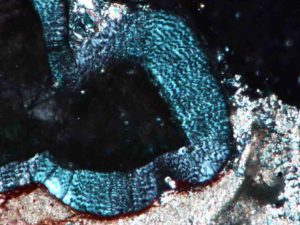
Two new research papers take a bite out of the mysteries around how early dinosaurs and mammals evolved their unique tooth replacement and anchoring systems.
The studies, involving Professor Robert Reisz, a paleontologist at the University of Toronto Mississauga, appear in the latest issues of PLOS ONE and the Proceedings of the Royal Society B.
In the first paper, Reisz and his colleagues at Jilin University in China examined the teeth of Changchunsaurus parvus, a small herbivorous dinosaur from the Cretaceous period.
Ornithischian (“bird-hipped”) dinosaurs developed an incredible diversity of teeth, including the complex dental batteries of derived ornithopods (like the famous duck-bill dinosaurs), but little is known about how these intricate arrangements arose from the simple tooth arrangements of early dinosaurs. Changchunsaurus parvus belongs to a branch at or near the origins of the ornithopods, and thus may provide insight into early ornithopod tooth development.
In this study, Reisz and his colleagues found a unique method of tooth replacement that allowed Changchunsaurus to recycle teeth without disrupting the continuous shearing surface formed by its tooth rows. The authors also found that the teeth feature wavy enamel, a tissue type formerly thought to have evolved only in more modern ornithopods. The authors suspect these features may have arisen early on as this group of dinosaurs became specialized for eating plants.
The whole tooth: how mammals evolved their unique tooth anchoring system
In the second study, published in the Proceedings of the Royal Society B, Reisz worked with his students who are now at the University of Alberta and the University of British Columbia, as well as collaborators at the University of Washington in Seattle, and the Unidad Ejecutora Lillo in Argentina.
Any person who has worn braces knows that your teeth can slowly be pushed and pulled into their proper spots. What you may not know is that this movement is made possible by a special ligament that holds each tooth in its socket. This ligament also serves to cushion each tooth as we chew our food. The origins of this ligament, however, have been a mystery.
This study, led by former University of Toronto Mississauga PhD student Aaron LeBlanc, has solved the mystery surrounding how mammals evolved their complex tooth-anchoring system. For over a hundred years, scientists thought that this ligament evolved with the earliest mammals when they first began to chew, but this new paper shows that this system appeared first in the extinct relatives of mammals, called the therapsids.
By examining CT scans and making thin sections of fossil therapsid teeth and jaws for microscopic study, LeBlanc and his colleagues found that mammal teeth are not as unusual as we once thought. “We found evidence for this ligament system in several groups of extinct therapsids, telling us that it evolved before the first mammals were chewing their food,” says LeBlanc.
The researchers also think they’ve figured out how our therapsid ancestors evolved this ligament anchoring system. They found that in many of the fossil synapsid jaws, the teeth were rapidly fused in place by this encroaching bone, but in some therapsids, the surrounding bone grew more slowly.
“We found that some therapsids, like mammals, must have evolved this ligament anchoring system not by developing brand new tissues, but by delaying the growth of the surrounding bone,” says Reisz. “We’ve re-framed how we view the mammalian condition. We don’t think that mammals are more ‘advanced’ than the other extinct therapsids, but instead mammal teeth are frozen in an earlier state of development compared to animals that have teeth fused to the jaws.”
Both studies undertaken at the University of Toronto Mississauga involve teeth that are not firmly anchored to the jaws, but rather held in place by ligaments. There is now clear evidence that ligaments are present in both carnivorous and herbivorous dinosaurs and mammals, and these ligaments are not necessarily related to the evolution of chewing, as previously thought. Reisz hopes that ongoing research will continue to reveal a better understanding of this interesting enigma.
Reference:
Chen J, LeBlanc ARH, Jin L, Huang T, Reisz RR (2018) Tooth development, histology, and enamel microstructure in Changchunsaurus parvus: Implications for dental evolution in ornithopod dinosaurs. PLoS ONE 13(11): e0205206. DOI: 10.1371/journal.pone.0205206
Note: The above post is reprinted from materials provided by University of Toronto.










